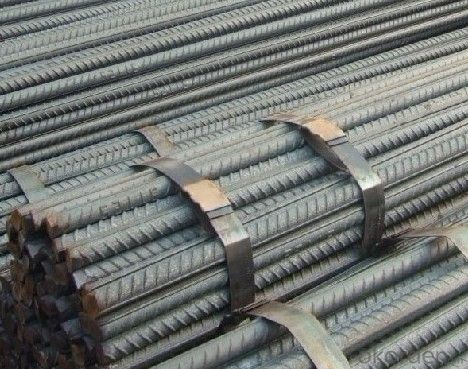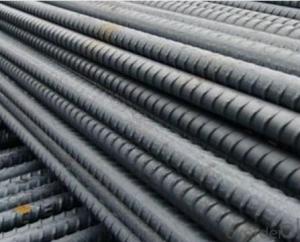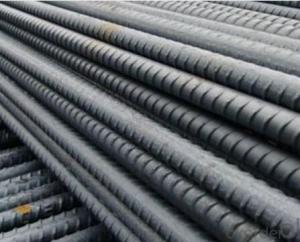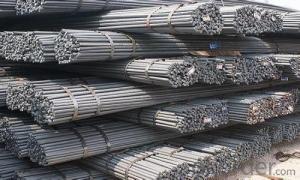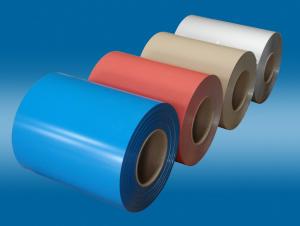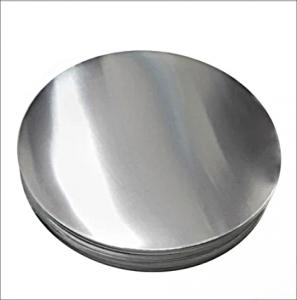Rebar Number 4 S65C Deformed Steel Bars for Construction Standard
- Loading Port:
- Tianjin
- Payment Terms:
- TT or LC
- Min Order Qty:
- 25 m.t.
- Supply Capability:
- 100000 m.t./month
OKorder Service Pledge
OKorder Financial Service
You Might Also Like
Product Description:
OKorder is offering S65C deformed steel bars for construction standard at great prices with worldwide shipping. Our supplier is a world-class manufacturer of steel, with our products utilized the world over. OKorder annually supplies products to European, North American and Asian markets. We provide quotations within 24 hours of receiving an inquiry and guarantee competitive prices.
Product Applications:
S65C deformed steel bars are ideal for structural applications and are widely used in the construction of buildings and bridges, and the manufacturing, petrochemical, and transportation industries.
Product Advantages:
OKorder's deformed steel bars are durable, strong, and resist corrosion.
Main Product Features:
· Premium quality
· Prompt delivery & seaworthy packing (30 days after receiving deposit)
· Corrosion resistance
· Can be recycled and reused
· Mill test certification
· Professional Service
· Competitive pricing
Product Specifications:
Specifications
1.commodity:deformed steel bars
2.grade:ASTM A615 HRB335 HRB400 HRB500 BS4449 grade460
3.size:6#-32#
4.length:6m 9m 12m
We henglong can offer high quality deformed steel bar
grade:ASTM A615 BS4449 GRADE460 HRB335 HRB400 HRB500
size:6# to 32#
length:6M 9M 12M
Chemistry % | |||||||||||||
Designation | Chief component | Impurities maxmium | |||||||||||
Ta | Nb | Fe | Si | Ni | W | Mo | Ti | Nb | O | C | H | N | |
Ta1 | Remainder | 0.004 | 0.003 | 0.002 | 0.004 | 0.004 | 0.002 | 0.03 | 0.015 | 0.004 | 0.0015 | 0.002 | |
Ta2 | Remainder | 0.01 | 0.01 | 0.005 | 0.02 | 0.02 | 0.005 | 0.08 | 0.02 | 0.01 | 0.0015 | 0.01 | |
Permissible variations in diameter for rods
Diameter, inch (mm) | Tolerance, +/-inch (mm) |
0.125~0.187 excl (3.175~4.750) | 0.003 (0.076) |
0.187~0.375 excl (4.750~9.525) | 0.004 (0.102) |
0.375~0.500 excl (9.525~12.70) | 0.005 (0.127) |
0.500~0.625 excl (12.70~15.88) | 0.007 (0.178) |
0.625~0.750 excl (15.88~19.05) | 0.008 (0.203) |
0.750~1.000 excl (19.05~25.40) | 0.010 (0.254) |
1.000~1.500 excl (25.40~38.10) | 0.015 (0.381) |
1.500~2.000 excl (38.10~50.80) | 0.020 (0.508) |
2.000~2.500 excl (50.80~63.50) | 0.030 (0.762) |
For more details please go to our website, and welcome to China to visit our company.
Special requirements to be agreed on by the supplier and buyer of negotiation.
Note:
1. Our products are produced according to national standard (GB), if not, supply according to national standards (GB) or agreement as customer required.
2. Other Grade and Standard Deformed Steel Bar we can supply:
Grade: GR40/GR60, G460B/B500A/B500B/B500C,BST500S
Standard: ASTM, BS, DIN
The Minimum Order Quantity of these products is high, and need to be confirmed.
3. We can not only supply Deformed Steel Bar; if you need anything about building materials, please contact us for further information.
4. Please send us your detail specifications when inquire. We will reply to you as soon as possible. We sincerely hope we can establish a long stable business relationship.
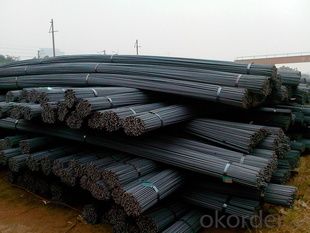

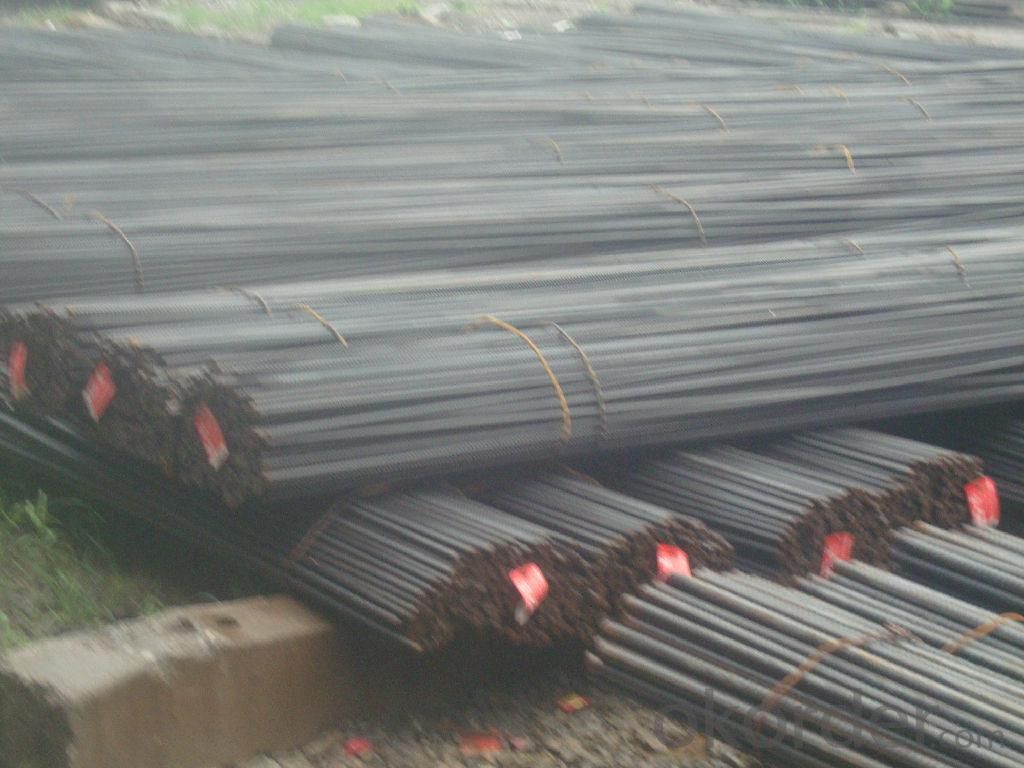
FAQ:
Q1: What makes stainless steel stainless?
A1: Stainless steel must contain at least 10.5 % chromium. It is this element that reacts with the oxygen in the air to form a complex chrome-oxide surface layer that is invisible but strong enough to prevent further oxygen from "staining" (rusting) the surface. Higher levels of chromium and the addition of other alloying elements such as nickel and molybdenum enhance this surface layer and improve the corrosion resistance of the stainless material.
Q2: Can stainless steel rust?
A2: Stainless does not "rust" as you think of regular steel rusting with a red oxide on the surface that flakes off. If you see red rust it is probably due to some iron particles that have contaminated the surface of the stainless steel and it is these iron particles that are rusting. Look at the source of the rusting and see if you can remove it from the surface.
- Q:Are steel rebars suitable for use in aggressive environments?
- Indeed suitable for use in aggressive environments are steel rebars. Commonly utilized in construction projects, particularly in reinforced concrete structures, steel rebars possess high tensile strength and durability. However, when exposed to corrosive elements like moisture, chloride ions, and chemicals, corrosion may occur, leading to weakened rebars and compromised structural integrity of the concrete. To counteract this issue, protective materials such as epoxy or zinc are often applied to steel rebars, creating a barrier against corrosion. Moreover, stainless steel rebars, with their superior corrosion resistance properties, are also employed in aggressive environments. In conclusion, although steel rebars generally prove suitable for aggressive environments, it is essential to consider specific conditions and implement appropriate protective measures to prevent corrosion and uphold the longevity of the reinforced concrete structure.
- Q:How do steel rebars contribute to the structural integrity of a building?
- The structural integrity of a building is greatly enhanced by steel rebars, which play a vital role in this regard. Rebars, also known as reinforcing bars, are typically made of steel and are used to provide strength and stability to concrete structures. They are embedded within the concrete to create a composite material capable of withstanding various forces and loads. To begin with, rebars aid in the distribution and transfer of loads across the structure. When external forces such as wind, earthquakes, or heavy loads act upon a building, the rebars act as reinforcements, absorbing and dispersing these forces. By spreading the load over a larger area, they prevent concentrated stress points that could potentially lead to structural failure. Furthermore, rebars help prevent cracks and fractures in the concrete. Although concrete is highly durable under compression, it is weak in tension. Steel rebars, with their high tensile strength, counteract this weakness by resisting the tensile forces that could cause the concrete to crack or fail. By reinforcing the concrete, rebars ensure that the structure remains intact and can withstand various stresses. Additionally, rebars increase the overall durability and lifespan of a building. By providing additional strength and stability, they reduce the likelihood of structural damage, ensuring that the building can endure over time. This is particularly crucial in areas prone to natural disasters, where the strength of a building can be a matter of life and death. Lastly, steel rebars contribute to the overall safety of a building. By reinforcing the structure, they enhance its ability to withstand extreme events such as earthquakes or heavy impacts. This not only protects the occupants of the building but also reduces the risk of collateral damage to surrounding structures. In conclusion, steel rebars are indispensable components in construction that significantly contribute to a building's structural integrity. Their ability to distribute loads, prevent cracks, increase durability, and enhance safety make them a crucial element in modern construction practices.
- Q:Can steel rebars be used in stadium and sports arena construction?
- Steel rebars are suitable for use in stadium and sports arena construction. These reinforcing bars, known as rebars, are commonly utilized in concrete structures to provide durability and strength. Given the massive nature of stadiums and sports arenas, they must be capable of withstanding substantial loads and forces, such as the weight of the stands and the impact from crowds and sporting events. Steel rebars possess exceptional tensile strength, making them an excellent option for reinforcing the concrete used in these structures. Moreover, they effectively distribute and resist these loads. An additional advantage is that steel rebars can be easily shaped and bent to meet the specific design requirements of the stadium or sports arena, making them a versatile and pragmatic choice for projects of this magnitude.
- Q:Are steel rebars resistant to UV radiation?
- No, steel rebars are not inherently resistant to UV radiation.
- Q:What is the difference between carbon steel and stainless steel rebars?
- Both carbon steel and stainless steel rebars are utilized in construction as types of steel reinforcement. However, they differ significantly in their composition and properties. Carbon steel rebars consist of a combination of iron and carbon, with trace amounts of other elements like manganese and copper. The carbon content in these rebars typically ranges from 0.15% to 0.60%. They possess strength, durability, and cost-effectiveness. Their tensile strength is crucial for reinforcing concrete structures. Nevertheless, they are prone to corrosion if not adequately protected, especially in environments with high moisture or exposure to chemicals. On the contrary, stainless steel rebars are created by combining iron, chromium, nickel, and other alloying elements. The chromium content in stainless steel usually exceeds 10.5%, leading to the formation of a protective layer of chromium oxide on the rebar's surface, which prevents corrosion. Stainless steel rebars exhibit exceptional corrosion resistance, even in harsh environments with high humidity, saltwater, or exposure to chemicals. Additionally, they are highly durable and possess high tensile strength, similar to carbon steel rebars. The primary distinction between carbon steel and stainless steel rebars lies in their corrosion resistance. Carbon steel rebars necessitate the application of protective coatings like epoxy or galvanization to prevent corrosion. In contrast, stainless steel rebars possess inherent corrosion resistance due to the presence of the chromium oxide layer, eliminating the need for additional coatings. Another differing factor is the cost. Carbon steel rebars are generally more affordable compared to stainless steel rebars. However, the total project cost should also consider the long-term maintenance expenses associated with corrosion protection measures required for carbon steel rebars. To summarize, carbon steel rebars are strong and cost-effective but require supplementary corrosion protection, while stainless steel rebars exhibit excellent corrosion resistance and durability at a higher cost. The selection between the two depends on the specific project requirements, budget constraints, and anticipated environmental conditions.
- Q:What are the factors that affect the strength of steel rebars?
- Several factors can affect the strength of steel rebars: 1. Composition: The composition of the steel bar plays a crucial role in determining its strength. Steel rebars typically have a carbon content ranging from 0.15% to 0.6%, which affects their hardness and strength. Other elements such as manganese, silicon, and sulfur can also impact the strength of the rebar. 2. Manufacturing process: The process used to manufacture steel rebars can influence their strength. The bars are generally made through hot rolling, which involves heating the steel billets to high temperatures and then passing them through rollers to shape them. The cooling rate during the manufacturing process can affect the internal microstructure of the bar, leading to variations in strength. 3. Size and shape: The size and shape of the rebar can affect its strength. Thicker and larger diameter rebars generally have higher strength capacities compared to thinner ones. Similarly, the shape of the rebar, whether it is a plain round bar or has deformations like ribs, can also impact its strength. 4. Heat treatment: Certain heat treatment processes can be applied to steel rebars to enhance their strength. For example, quenching and tempering involve heating the rebar to a high temperature and then rapidly cooling it to increase its strength and hardness. The specific heat treatment process used will depend on the desired strength requirements. 5. Corrosion: Corrosion can significantly reduce the strength of steel rebars over time. When exposed to moisture and oxygen, steel rebars can rust, leading to structural degradation. Proper corrosion protection measures, such as epoxy coating or galvanization, can help maintain the strength and durability of the rebars. 6. Loading conditions: The strength of steel rebars can be influenced by the type and magnitude of the applied loads. Different applications require rebars with varying strength capacities. The design and engineering of structures should consider the expected loads to determine the appropriate strength of the rebars used. Overall, the strength of steel rebars is influenced by their composition, manufacturing process, size and shape, heat treatment, corrosion protection, and the loading conditions they will be subjected to. It is essential to consider these factors when selecting and using steel rebars in construction projects.
- Q:What is the impact of steel rebars on the carbon footprint of a building?
- The carbon footprint of a building is greatly influenced by steel rebars, which are manufactured through a process that involves extracting raw materials like iron ore and then smelting and refining them into steel. This production phase alone results in greenhouse gas emissions and consumes a significant amount of energy. Furthermore, the transportation and construction of steel rebars also contribute to the building's carbon footprint. Fossil fuels are used for transportation, releasing carbon dioxide into the atmosphere. Moreover, the construction phase relies on heavy machinery and equipment that further adds to carbon emissions because of their dependence on fossil fuels. The carbon footprint of steel rebars extends beyond the construction phase as well. While steel is highly durable and can last for many years, it requires maintenance and may need to be replaced over time. These activities, such as repairs or demolitions, result in additional carbon emissions due to transportation, energy consumption, and waste management. However, it is important to acknowledge that steel rebars can offer environmental benefits when used in high-performance buildings or sustainable construction practices. For example, steel is recyclable, and reusing steel rebars can significantly reduce the carbon footprint associated with their production. Additionally, steel rebars provide structural strength, enabling the construction of taller and more efficient buildings that can potentially reduce long-term energy consumption. To minimize the carbon footprint of a building, it is crucial to consider alternative materials like recycled steel or other low-carbon materials during the construction process. Additionally, implementing energy-efficient practices throughout the building's lifecycle, including reducing energy consumption and improving waste management, can further mitigate the environmental impact of steel rebars.
- Q:How do steel rebars contribute to the overall occupant comfort of a building?
- Steel rebars contribute to the overall occupant comfort of a building by providing structural strength and stability. They reinforce the concrete, ensuring that the building can withstand various forces such as wind, earthquakes, and heavy loads. This enhances the safety of the occupants, assuring them of a secure and stable structure. Additionally, steel rebars help in maintaining the integrity of the building over time, reducing the risk of cracks or structural failures that could negatively impact occupant comfort.
- Q:Can steel rebars be used in underground parking garage construction?
- Indeed, steel rebars find utility in the construction of underground parking garages. They are frequently employed in the reinforcement of concrete structures, including those built below the ground level. By endowing the concrete with strength and reinforcement, the rebars enable it to withstand the immense weight and pressure exerted by the structure above. Moreover, steel rebars possess remarkable resistance to corrosion—a quality of utmost significance in subterranean environments where moisture and other corrosive agents are likely to exist. In summary, steel rebars emerge as a dependable and widely preferred option for reinforcing concrete during the construction of underground parking garages.
- Q:Can steel rebars be used in pre-tensioned or post-tensioned structures?
- Yes, steel rebars can be used in both pre-tensioned and post-tensioned structures. In pre-tensioned structures, the rebars are tensioned before the concrete is poured, creating a compressive force in the concrete. In post-tensioned structures, the rebars are tensioned after the concrete has hardened, allowing for greater flexibility in design and reducing cracking.
1. Manufacturer Overview |
|
|---|---|
| Location | |
| Year Established | |
| Annual Output Value | |
| Main Markets | |
| Company Certifications | |
2. Manufacturer Certificates |
|
|---|---|
| a) Certification Name | |
| Range | |
| Reference | |
| Validity Period | |
3. Manufacturer Capability |
|
|---|---|
| a)Trade Capacity | |
| Nearest Port | |
| Export Percentage | |
| No.of Employees in Trade Department | |
| Language Spoken: | |
| b)Factory Information | |
| Factory Size: | |
| No. of Production Lines | |
| Contract Manufacturing | |
| Product Price Range | |
Send your message to us
Rebar Number 4 S65C Deformed Steel Bars for Construction Standard
- Loading Port:
- Tianjin
- Payment Terms:
- TT or LC
- Min Order Qty:
- 25 m.t.
- Supply Capability:
- 100000 m.t./month
OKorder Service Pledge
OKorder Financial Service
Similar products
New products
Hot products
Hot Searches
Related keywords



